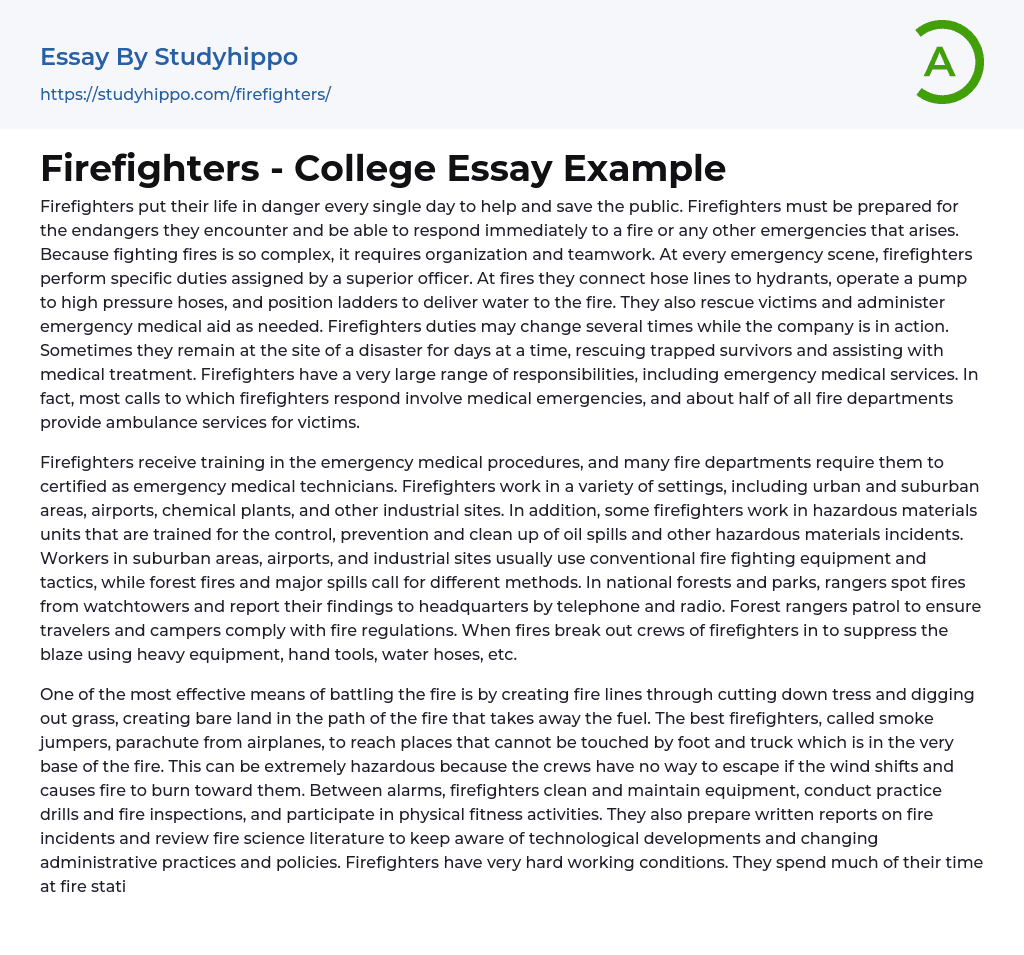Firefighters risk their lives daily to save and assist the public, responding quickly to fires and emergencies. Organizational skills and teamwork are crucial due to the complexity of firefighting. At emergency scenes, firefighters follow instructions from a superior officer, connecting hoses to hydrants, operating pumps to pressurize hoses, and positioning ladders for extinguishing fires with water. They also rescue victims and provide necessary emergency medical aid. Firefighters may have their duties changed multiple times during a shift. Sometimes they stay at disaster sites for several days, rescuing survivors and providing medical treatment. Additionally, firefighters offer emergency medical services as around 50% of fire departments provide ambulance services.
Firefighters receive training in emergency medical procedures and often need certification as emergency medical technicians. They work in various settings, such as urban and suburban area
...s, airports, chemical plants, and industrial sites. Some firefighters specialize in hazardous materials units where they handle incidents involving substances like oil spills by controlling, preventing, and cleaning them up. Firefighters stationed in suburban areas, airports, and industrial sites use conventional firefighting equipment and tactics. However, different methods are needed to combat forest fires and major spills.
In national forests and parks, rangers utilize watchtowers to detect fires which they then report through telephone or radio communication to headquarters. Forest rangers also patrol the area to ensure compliance with fire regulations by travelers and campers. When fires occur in these regions, teams of firefighters equipped with heavy machinery, hand tools, water hoses etc., are sent out to suppress the blaze.
Creating fire lines through tree cutting and grass digging is one of the most effective methods for combattin
fires. This involves clearing the path of the fire, removing fuel by creating bare land. The smoke jumpers, who are the best firefighters, parachute from airplanes to reach inaccessible areas that cannot be reached by foot or truck. Despite its effectiveness, this strategy is incredibly risky as the crews have no means of escape if the wind changes direction and the fire moves towards them. Alongside responding to alarms, firefighters engage in various tasks such as cleaning and maintaining equipment, conducting practice drills and inspections, and participating in physical fitness activities. They also remain updated on technological advancements and changes in administrative practices and policies by reviewing fire science literature and preparing written reports on fire incidents. Firefighters endure challenging working conditions, with much of their time spent at fire stations that resemble residential facilities with dorm-like features.
Regardless of weather or time, firefighters promptly respond to alarms. Firefighting involves risks such as traffic accidents, exposure to flames and smoke, and contact with toxic, flammable, or explosive gases and chemicals, including radioactive or other hazardous materials that can have immediate or long-term health effects. Consequently, firefighters must wear heavy and hot protective gear. Compared to other workers, firefighters have longer and more variable hours. Many surpass 50 hours per week and sometimes work even longer. Some work sites follow a pattern of 24-hour shifts followed by 48 hours off with an additional day off at intervals. Others switch between 10-hour day shifts for 3 to 4 days and 14-hour night shifts for the same duration before enjoying 3 to 4 days off before repeating the cycle. Moreover, firefighters often work extra hours at fires
and emergencies while also being regularly assigned holiday shifts.
Fire lieutenants and fire captains have the same working hours as the firefighters they oversee. This includes studying, training, and conducting fire prevention duties. Volunteer firefighters, who perform similar tasks, are often the majority in residential areas. In 1998, there were approximately 314,000 paid career firefighters. The majority of them (over 90%) worked in municipal or county fire departments. Larger cities may have thousands of career firefighters while smaller towns may only have a few. The remaining firefighters were employed at federal and state installations like airports. Private firefighting companies also employ a small number of firefighters on a subscription basis. Applicants for firefighting jobs usually need to pass a written exam, physical tests assessing strength and stamina along with coordination and agility assessments, as well as a medical examination that includes drug screening.
After being hired, employees may be randomly tested for drugs. These tests usually target individuals who are at least 18 years old and have a high school education. In larger fire departments, new employees typically receive several weeks of training at the department's training center or academy. This training includes both classroom instruction and hands-on activities that cover various aspects of firefighting, such as techniques, prevention methods, hazardous materials control, local building codes, and emergency medical procedures. In addition to this, recruits learn how to operate firefighting and rescue equipment like axes, chainsaws, fire extinguishers, and other tools. Once they successfully complete this training program, they are assigned to a fire company where they will go through a probationary period.
- John Locke essays
- 9/11 essays
- A Good Teacher essays
- A Healthy Diet essays
- A Modest Proposal essays
- A&P essays
- Academic Achievement essays
- Achievement essays
- Achieving goals essays
- Admission essays
- Advantages And Disadvantages Of Internet essays
- Alcoholic drinks essays
- Ammonia essays
- Analytical essays
- Ancient Olympic Games essays
- APA essays
- Arabian Peninsula essays
- Argument essays
- Argumentative essays
- Art essays
- Atlantic Ocean essays
- Auto-ethnography essays
- Autobiography essays
- Ballad essays
- Batman essays
- Binge Eating essays
- Black Power Movement essays
- Blogger essays
- Body Mass Index essays
- Book I Want a Wife essays
- Boycott essays
- Breastfeeding essays
- Bulimia Nervosa essays
- Business essays
- Business Process essays
- Canterbury essays
- Carbonate essays
- Catalina de Erauso essays
- Cause and Effect essays
- Cesar Chavez essays
- Character Analysis essays
- Chemical Compound essays
- Chemical Element essays
- Chemical Substance essays
- Cherokee essays
- Cherry essays
- Childhood Obesity essays
- Chlorine essays
- Classification essays
- Cognitive Science essays




